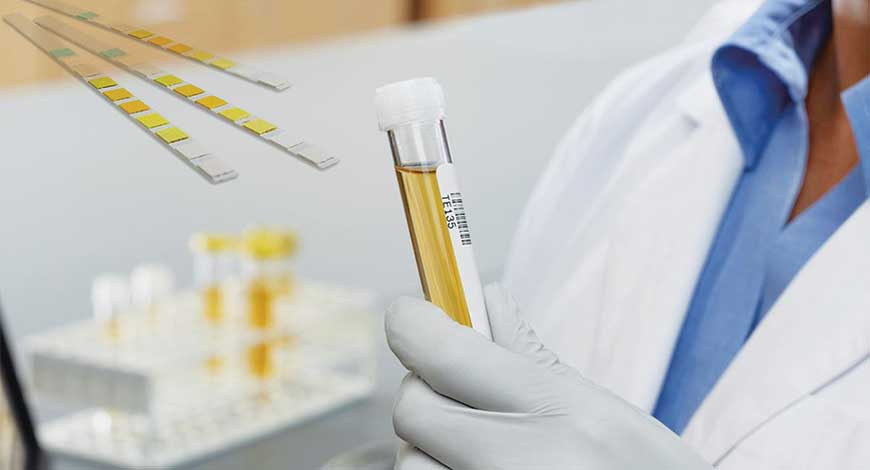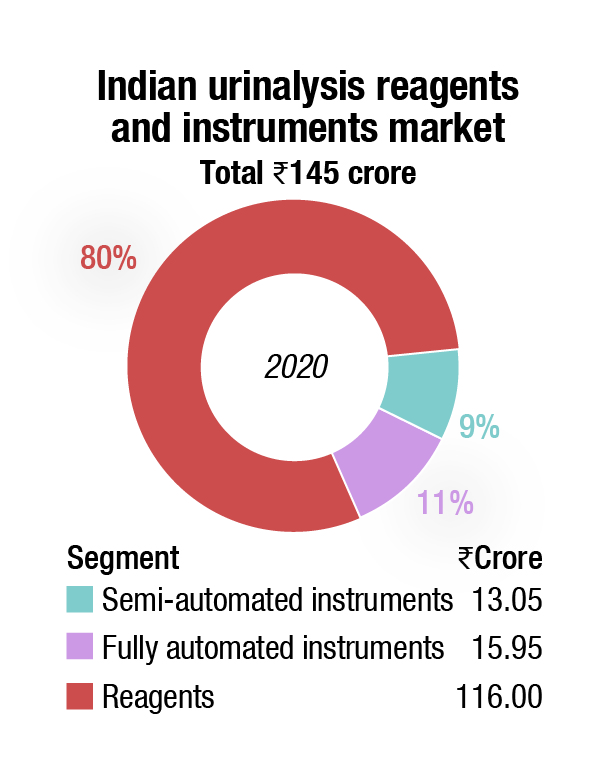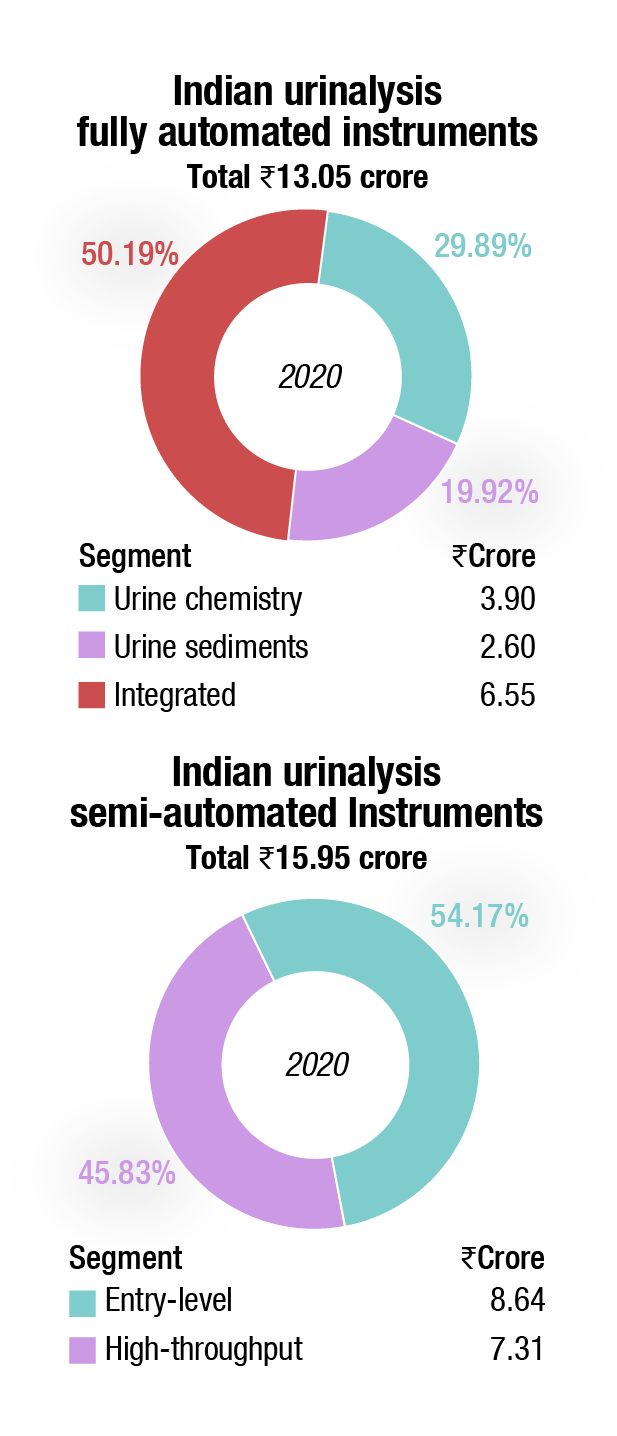IVD
An unexciting market

Urinalysis not directly needed for COVID-19 testing is attempting to find relevance.
Urinalysis instruments and reagents not being needed for detecting the coronavirus, unlike their counterpart, the molecular diagnostics, the segment was drastically hurt ever since the virus reared its ugly head, and raged havoc across the world. However, the values of urinary disorders such as urinary tract infections, kidney disease, and diabetes vary when comparing urine samples of normal patients with those of COVID-19 patients. This mainly happens as the coronavirus affects the kidney organ.
According to a study published in Clinical Chemistry and Laboratory Medicine Journal, the urine sediment analysis revealed the presence of erythrocytes and casts in nearly half of the patients; and a sediment analysis of COVID-19 urine samples detected the presence of myoglobin casts or cellular debris casts, diffused erythrocyte aggregation, and obstruction in the lumen of glomerular, peritubular capillaries without platelets, red blood cell fragments, fibrin thrombi, or fibrinoid necrosis. A urinary sediment analysis study also in acute kidney injury associated with COVID-19 revealed a fair abundance of coarse granular casts and muddy brown granular casts in 75 percent of the cases, whereas half of the specimens revealed the presence of waxy casts, and a smaller fraction contained renal tubular epithelial cell casts.

Similar other studies made urinalysis analysis relevant at these times when other routine tests were at absymal low levels.
Urinalysis has always been a major diagnostic screening test in diagnosing and monitoring nephrological and urological conditions. Until recently, microscopic urine sediment analysis was the most widely accepted urinalysis methodology. However, this time-consuming methodology is associated with extensive analytical errors. Over the past 25 years, new automated technologies and informatics have greatly reduced the labor intensity of urinalysis and have created new technical possibilities.
| Segement | Brand | |
|---|---|---|
| Urine chemistry | Dirui, Beckman Coulter, Rapid, Siemens, Roche, and Agappe | |
| Urine sediments | Sysmex, Dirui, Roche, URIT, Beckman Coulter, and 77 Electronika (Suyog) |
|
| Integrated | Sysmex, Dirui, Transasia, 77 Electronika (Suyog), Siemens, and Roche |
|
| Tier I | Tier II | Tier III |
|---|---|---|
| Transasia | Dirui and Mission | Standard Diagnostics (Abbott), Agappe, Iris, and Rapha |
| *Vendors are placed in different tiers on the basis of their sales contribution to the overall revenues of the Indian urinalysis instruments and reagents market. |
||
| FA reagents | Sysmex, Iris, Beckman Coulter, 77 Electronika (Suyog), Siemens, Dirui, YD Diagnostics, and Agappe |
| SA reagents | Transasia, Siemens, Dirui, Mission, SD, Agappe, Iris, and Rapha |
| ADI Media Research |
New technological advances have paved the way for significant progress in automated urinalysis. Quantitative reading of urinary test strips using reflectometry has become possible, while complementary metal oxide semiconductor (CMOS) technology has enhanced analytical sensitivity and shown promise in microalbuminuria testing.
Microscopy-based urine particle analysis has greatly progressed over the past decades, enabling high throughput in clinical laboratories. Urinary flow cytometry is an alternative for automated microscopy, and more thorough analysis of flow cytometric data has enabled rapid differentiation of urinary microorganisms. Integration of dilution parameters in urine test strip readers and urine particle flow cytometers enables correction for urinary dilution, which improves result interpretation. Automated urinalysis can be used for urinary tract screening and for diagnosing and monitoring a broad variety of nephrological and urological conditions; newer applications show promising results for early detection of urothelial cancer.
The introduction of matrix-assisted laser desorption ionization-time-of-flight mass spectrometry (MALDI-TOF MS) has enabled fast identification of urinary pathogens. Automation and workflow simplification have led to mechanical integration of test strip readers and particle analysis in urinalysis.
As the information obtained by urinalysis is complex, the introduction of expert systems may further reduce analytical errors and improve the quality of sediment and test strip analysis. With the introduction of laboratory-on-a-chip approaches and the use of microfluidics, new affordable applications for quantitative urinalysis and readout on cell phones may become available.
The Indian market for urinalysis analyzers and reagents in 2020 is estimated at ₹145 crore. Reagents continue to dominate with an 80-percent share, valued at ₹145 crore. The market took a major hit in 2020, and continues to be on lower levels than 2019, since urinalysis has minimal role to play in COVID-19 testing or treatment.
The fully automated analyzers segment is estimated at ₹13.05 crore in 2020. In the semi-automated instruments category, amounting to ₹15.95 crore, the entry level instruments are marginally higher contributing 54 percent to the segment, by value.

One of most popular routine health-screening tests, 2020 has not been a great year for this segment. Molecular diagnostics, the mainstay for COVID-19 testing is completely different. A team in India comprising Supraja Sundaram, Mamta Soni, and Rajeev Annigeri have put forth their study that urine abnormalities predict acute kidney injury in COVID-19 patients. Their results suggest that urine analysis is a simple test, which can be used to predict development of AKI and mortality and may be used for risk stratification of COVID-19 patients, especially in low resource settings. With the opening of the lockdown, 2021 seems more promising, although not expected to reach 2019 levels.
The global urinalysis instruments and reagents market was valued at USD 12.41 million in 2020 and is expected to grow at a CAGR of 12.22 percent from 2020 to 2027 by Market Watch. This is primarily driven by the rising global prevalence of kidney diseases and urinary tract infections, growing geriatric population, introduction of technologically advanced diagnostics, and increasing adoption of point-of-care devices for urinalysis. However, the presence of ambiguous regulatory frameworks hinders growth.The instruments segment is anticipated to show the highest share in the urinalysis market over the next 6 years. The enhanced wireless communication along with the miniaturized instruments for POC urinalysis is contributing to the growth of the market. Such advancements enable the access to the urinalysis results at the same time across the hospital.
 The growing preference for automated urine analyzers
The growing preference for automated urine analyzers
Grieston Fonseca
Asst. Manager-Urinalysis,
Transasia Bio-Medicals Ltd.
Time and again, routine urinalysis has proved its clinical utility for screening, diagnosing, and monitoring of renal, urological, and metabolic conditions. It also plays an important role in the evaluation of liver function and several urological malignancies. In addition to detecting leukocytes and nitrites, a urine microscopy identifies bacteria. These findings are crucial to the treatment process. In the current pandemic, urinalysis is a useful in unveiling potential renal impairment due to COVID-19.
Technological advancements
Adoption of automation in sediment analysis has paved the way for significant progress in urinalysis. These systems reduce human intervention, making it possible to standardize results, and streamline workflow and increase laboratory productivity.
AI based element identification systems. Integration of AI with digital bright-field microscopy in automated sediment analyzers provides clear, high quality images mimicking visual microscopy. These systems are enabled to recognize thousands of known sediment elements. This considerably reduces repetitions, while improving accuracy and reliability of sediment particle detection and differentiation. Additionally, when an atypical cell appears on the screen, the pathologist can check the accuracy of the automatic identification and further evaluate to confirm the sub-types.
Expert systems reduce analytical errors in sediment and test strip analysis.
Integrated operating mode. Fully automated analyzers integrate analysis of chemical parameters on test strips and urine sediment examination in a format compatible with manual microscopy.
Gravity sedimentation. Compared to centrifugation, gravity sedimentation ensures less damage to fragile elements like casts, and a lower risk of RBC lysis. This result in cost savings as it allows re-use of cuvettes.
Active humidity protection of diagnostic strips. Dessicators and silica gel bags, aid in maintaining humidity up to 40 percent lower than ambient humidity, eliminating false positive results.
Among other benefits, these technological advancements lead to decreased usage of consumables, resulting in cost-effective operations. With greater emphasis on early detection of chronic kidney disease and diabetic nephropathy fueling high demand for urinalysis, fully automated systems are proving to be a boon for pathology laboratories with high workload in government medical colleges, corporate hospitals and chain labs.
Initially, the technique was regarded as a necessary, labor-intensive procedure that provided invaluable but limited information for clinicians. However, in recent years, various innovations have been introduced, and new technologies have been integrated to improve the clinical outcomes of the technique with high-accuracy testing instruments and reagents. Recently, a new generation of analyzers that integrates and automates the two primary functions: chemistry and microscopic particle analysis have been introduced. For instance, the UN-2000 is an integrated system manufactured by Sysmex Corporation. It features the UD-10, a urinalysis digital imaging system, and the UF-5000, a fully automated urine particle analyzer, to increase the efficiency of the urine particle analysis. AVE Science & Technology manufactures the AVE-772 integrated urinalysis analyzer, a combination of a urine-formed elements analyzer and a urine analyzer. This system can analyze 11-14 parameters in the sample with microscopic measurements of cells, including RBCs, WBCs, epithelial cells, crystals, casts, mucus, yeast, and bacteria. Significant advances have been made by improving the quantitative reading of urinary test strips, integrating dilution parameters in test strip readers, and adopting reflectometry and complementary metal-oxide-semiconductor (CMOS) technology to enhance analytical sensitivity.
Key players operating in the global urinalysis market include Urit Medical Electronic Ltd., Acon Laboratories, 77 Elektronika Kft, Beckman Coulter, Sysmex Corporation, Roche Diagnostics, Seimens Healthineers, Arkray Inc., Bio-Rad Laboratories, Quidel Corporation, Cardinal Health, Dirui and Alere Inc.
To gain a significant market share in the global urinalysis market, the key players are now focusing on adopting strategies such as product innovations, mergers & acquisitions, recent developments, joint ventures, collaborations, and partnerships.
For instance, in August 2020, Sysmex America signed an exclusive agreement with Siemens Healthineers that grants North American rights to distribute and service Siemens Healthineers Clinitek Novus automated urine analyzer for hospital and reference laboratory use.
Over the past 25 years, new automated technologies and informatics have greatly reduced the labor intensity of urinalysis, and have created new technical possibilities.
 Urinalysis-Automation is leading the way
Urinalysis-Automation is leading the way
Shobhit Jain
Product Manager – Biochemistry Marketing,
Sysmex India Pvt Ltd
Urine analysis comprises of physical, routine, and microscopic examination. It is an integral part of clinical laboratories and one of the most performed diagnostic tests. This simple, noninvasive test is potent screening tool for clinicians, which can provide as much as possible information on the status of renal, urological, infection, and metabolic function in the body. Apart from routine screening, it may also be helpful in uncovering status of disease that may not be showing significant signs or symptoms.
A lot of vital information can be obtained through urine examination, still its clinical utility is affected to a great extent by limitation of its conventional manual methods including bio-chemical and microscopy. Biochemical analysis is improved with reagent strips, but challenge remained in microscopic part. Other challenges like non standardization of process, person to person variation, centrifugation, and slide preparation needed a whole automated system in place with minimum human involvement and maximized automation.
In last decade there were paradigm shifts in laboratory operations and now automation is leading the way for urinalysis testing. Technological advancement in biochemical analysis and microscopic examination in urinalysis have helped to set and standardize process. Automation has changed the way of testing, reporting and documentation of laboratories with improved quality and lowered TAT. Some of the key features of automation in urinalysis are standardization, quality control, added clinical values, data management, accuracy, and reproducibility.
Automation in urinalysis can be further categorized in bio-chemical analysis and particle analysis (microscopy). In bio-chemical analysis, the CMOS sensor has played a great role in identifying strip pad position, optimizing detection area, correction of abnormal coloration. This cutting-edge technology has eliminated all possible errors due to manual process. Similarly, for particle analysis, fluorescence flow cytometry technology has great advantage as it can recognize specific and unique properties of different particles by size, labeling DNA, complexity, and specific features, and so determining the particle type. Also, high accuracy of bacteria counts and, accurate differentiation in RBC morphology (Isomorphic and Dysmorphic) are helping in faster diagnosis and better patient care. Looking at the facts, it can be concluded that future of urinalysis lies in automation.
Although dry-chemistry technology for urinary test strips has made limited progress, advances in electronic detection have considerably improved. An interesting recent evolution is the use of smartphones for reading and interpreting urine test strip results. According to the reflectance theory, the reciprocal value of reflectance readings is proportional to the concentration of the measured analyte.
In manual microscopy, several steps, such as centrifugation, decantation, and re-suspension, led to cellular lysis and loss. Progress in informatics and computer technology has enabled the development of automated microscopy based on pattern recognition.
Urine particle flow cytometers (UFCs) have improved count precision and accuracy, compared with visual microscopy and offer significant labor reduction. Clinical studies using UFCs have focused on diagnosis and monitoring of urinary tract infection; localization of the sites of hematuria; and diagnosis, monitoring, and exclusion of renal disease. Depolarized side-scattered light was introduced to improve crystal sensitivity and to better discriminate between RBCs and crystals; however, in contrast to microscopy-based readers, differentiation of crystals is not possible. A popular approach is combining test strips with UFCs for screening purposes either using both strips and UFC or by utilizing the urine strips for parameters unrelated to the UFC-analysed particles. As mechanical coupling of UFCs and test strip readers has been introduced, expert systems now take advantage of the combined information and apply user – definable decision criteria. This implementation significantly reduces microscopy review rates and saves time and labor cost.
In view of the great demand for the development of cost-effective portable readers, pocket-sized urine strip readers can be combined with dipsticks in a device that is capable to send digital information using a smartphone, offering a solution for detecting urological or nephrological diseases in regions with limited availability of experts. Advances in microfluidics have enabled the development of chip-based assays, which might change urinalysis in the years to come. Alongside conventional urinalysis applications integrated microfluidic chips show promise for the quantitative detection of bladder cancer cells in urine. Similarly, microfluidic paper devices have been described for detecting bacteria causing UTIs and sexually transmitted diseases in urine specimens.
Over the past 20 years, automated urinalysis has undergone a technical evolution. In this respect, automated test strip reading provides added value. Further integration of existing technologies may contribute to reduce turn-around times. Consolidation of clinical laboratories has also led to a reduction of their number and has increased the distance between patient and laboratory; this trend creates a major pre-analytical challenge. Despite improvements in standardization, most of errors in urinalysis occur outside of the analytical phase; pre-analytical steps, in particular, are much more vulnerable. As analytical variation has been greatly reduced, more efforts need to be focused on the pre-analytical phase.
 Clinical chemistry and urine analysis
Clinical chemistry and urine analysis
Biplab Kumar Sinha
General Manager – Sales & Marketing,
Beacon Diagnostics Pvt. Ltd.
Clinical chemistry comprising of immunochemistry, biochemistry, endocrinology, toxicology, engineering, informatics provides support to clinicians which improves diagnosis and treatment of patients for a wide variety of diseases. The increasing prevalence of acute and chronic infections is boosting the clinical chemistry testing needs. Sedentary lifestyle, unhealthy food habits are also anticipated to increase the clinical chemistry testing requirements.
The challenges in clinical chemistry testing are largely addressed by complex integration of robotics, liquid handling, and numerous other technologies that are used in pre-analytical, analytical, and post analytical area for clinical chemistry testing.
Technologies such as colorimetry, nephelometry, turbidimetry, reflectance photometry, ISE, chromatography, chemiluminescence are providing fast, easy to use and precise analysis in clinical chemistry testing.
From a simple semi-automated analyzer to very high throughput fully automated analyzers combined with modular systems for clinical chemistry, has heavily benefited the quality outcome for laboratories.
Choosing a chemistry analyzer will depend upon factors like type of testing needs by laboratory, sample handling, operational costs, turnaround time (TAT), STAT capabilities, and analyzer capability to handle micro volume samples.
Laboratory informatics and process management software together with significant implementation of quality control systems has improved both, productivity and quality which creates operational simplicity that requires minimal training for laboratory personals.
In addition to the clinical chemistry, urine analysis also remains as one of the important tool in diagnosis. It provides much better information for metabolic, renal and urologic disorders. Today urine analysis is used by clinicians from general screening to cancer detection.
There has been a steady progression in sophistication in urine analysis. Modern day analyzers integrate even the microscopic particulate analysis. Together with technology, introduction of new renal biomarkers, they revolutionize the diagnosis of conditions like acute tubular necrosis.
As an established IVD company Beacon, Diagnostic has kept pace with time and provided value added solutions in clinical chemistry and urine analysis segment.
The analyzer market continues to be as impacted as the rest of the lab industry with the uncertainty and unpredictability that ensues with the current state of affairs. While the extent of the impact brings ambiguity, the need for clinical laboratory solutions to support medical professionals remains constant.

Rekha Dubey
CEO
Aditya Birla Memorial Hospital
“Urinalysis market is going to witness a growth owing to high incidences of various diseases, pregnancy, hypertension, diabetes, and rising kidney issues. Furthermore, the growing prevalence of inactive lifestyle in individuals is leading to other health issues that need urine tests.
Urinalysis testing is used as the front-line diagnostic tool in the diagnosis of various metabolic abnormalities, UTIs, checking pregnancy, before surgery or routine check-ups. Urinalysis is also used as a disease management tool for the treatment of chronic diseases, such as diabetes, chronic kidney disease (CKD), urinary bladder cancer amongst others.
Over the past decade, laboratories and clinicians have contributed to a list of necessary features which have been incorporated in the latest versions of the urinalysis systems for point-of-care devices and homecare kits to analyze urine at home.
At Aditya Birla Hospital we have a dedicated diagnostic center with the latest and the most upgraded urinalysis instruments to ensure accurate results.”
Regardless of what the future holds for the urinalysis instruments market, the one thing that remains constant is change. And as changes in disease detection and management keep coming, the lab industry and its analyzers will keep meeting the challenges that the new trends present.
Copyright © 2024 Medical Buyer











